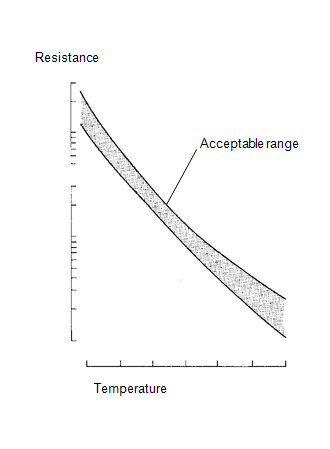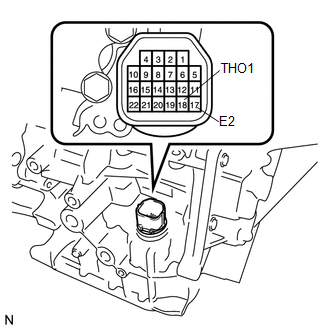Toyota Venza: Transmission Fluid Temperature Sensor "A" Circuit Low Input (P0712,P0713)
DESCRIPTION
The Automatic Transmission Fluid (ATF) temperature sensor converts the fluid temperature into a resistance value for use by the TCM.

The TCM applies a voltage to the temperature sensor through terminal THO1 of the TCM.
The sensor resistance changes with the transmission fluid temperature. As the temperature becomes higher, the sensor resistance decreases.
One terminal of the sensor is grounded so that the sensor resistance decreases and the voltage goes down as the temperature becomes higher.
The TCM calculates the fluid temperature based on the voltage signal.
|
DTC No. |
DTC Detection Condition |
Trouble Area |
|---|---|---|
|
P0712 |
ATF temperature sensor resistance is less than 79 Ω for 0.5 sec. or more (1-trip detection logic) |
|
|
P0713 |
ATF temperature sensor resistance is more than 156 kΩ for 0.5 seconds or more. Either of the following conditions is met (1 trip detection logic): |
|
|
Condition (A): 5 minutes and 45 sec. or more have elapsed after the engine start when engine coolant temperature or intake air temperature is -29.375°C (-20.875°F) or less. |
||
|
Condition (B): 10 seconds or more have elapsed after the engine start when engine coolant temperature and intake air temperature are more than -29.375°C (- 20.875°F). |
MONITOR DESCRIPTION
These DTCs indicate an open or short in the automatic transmission fluid (ATF) temperature sensor circuit. The automatic transmission fluid (ATF) temperature sensor converts ATF temperature into an electrical resistance value. Based on the resistance, the TCM determines the ATF temperature, and the TCM detects an open or short in the ATF temperature circuit. If the resistance value of the ATF temperature is less than 79 Ω*1 or more than 156 kΩ*2, the TCM interprets this as a fault in the ATF sensor or wiring. The TCM will turn on the MIL and store the DTC.
*1: 150°C (302°F) or more is indicated regardless of the actual ATF temperature.
*2: -40°C (-40°F) is indicated regardless of the actual ATF temperature.
HINT:
The ATF temperature can be checked on the Techstream display.
MONITOR STRATEGY
|
Related DTCs |
P0712: ATF temperature sensor/Range check (Low resistance) P0713: ATF temperature sensor/Range check (High resistance) |
|
Required sensors/Components |
ATF temperature sensor (TFT sensor) |
|
Frequency of operation |
Continuous |
|
Duration |
0.5 sec. |
|
MIL operation |
Immediate |
|
Sequence of operation |
None |
TYPICAL ENABLING CONDITIONS
- ALL
Battery voltage
8 V or more
Ignition switch
ON
Starter
OFF
- P0712: Range check (Low voltage)
The monitor will run whenever these DTCs are not present.
None
- One of the following conditions is met: Condition (A) or (B) Condition
(A)
Condition (B)Engine coolant temperature (ECT) or intake air temperature (IAT) at engine start
-29.375°C (-20.875°F) or less
Time after engine start
5 min. and 45 sec. or more
ECT sensor circuit fail (P0115, P0117, P0118)
Not detected
IAT sensor circuit fail (P0097, P0098, P0110, P0112, P0113)
Not detected
Engine coolant temperature (ECT) or intake air temperature (IAT) at engine start
More than -29.375°C (-20.875°F)
Time after engine start
10 seconds or more
ECT sensor circuit fail (P0115, P0117, P0118)
Not detected
IAT sensor circuit fail (P0097, P0098, P0110, P0112, P0113)
Not detected
TYPICAL MALFUNCTION THRESHOLDS
P0712: Range check (Low voltage)|
TFT sensor voltage (ATF temperature) |
Less than 0.14 V Higher than 164°C (327°F) |
|
TFT sensor voltage (ATF temperature) |
Higher than 4.91 V Less than -48°C (-54°F) |
COMPONENT OPERATING RANGE
|
ATF (TFT ) sensor resistance |
79 to 156 kΩ |
WIRING DIAGRAM
.png)
CAUTION / NOTICE / HINT
NOTICE:
Perform the universal trip to clear permanent DTCs (See page
.gif) ).
).
HINT:
Using the Techstream to read the Data List allows the values or states of switches, sensors, actuators and other items to be read without removing any parts. This non-intrusive inspection can be very useful because intermittent conditions or signals may be discovered before parts or wiring is disturbed. Reading the Data List information early in troubleshooting is one way to save diagnostic time.
NOTICE:
In the table below, the values listed under "Normal Condition" are reference values. Do not depend solely on these reference values when deciding whether a part is faulty or not.
- Warm up the engine.
- Turn the ignition switch off.
- Connect the Techstream to the DLC3.
- Turn the ignition switch to ON.
- Turn the Techstream on.
- Enter the following menus: Powertrain / ECT / Data List.
- According to the display on the Techstream, read the Data List. TCM
Tester Display
Measurement Item/Range
Normal Condition
Diagnostic Note
A/T Oil Temperature 1
ATF temperature sensor value/
Min.: -40°C (-40°F)
Max.: 215°C (419°F)
- After stall speed test: Approximately 80°C (176°F)
- While engine is cold:
Equal to ambient temperature
If value is -40°C (-40°F) or 150°C (302°F), ATF temperature sensor circuit is open or short circuited
HINT:
When DTC P0712 is output and the Techstream indicates 150°C (302°F) or more, there is a short circuit.
When DTC P0713 is output and the Techstream indicates -40°C (-40°F), there is an open circuit.
Measure the resistance between terminal THO1 (OT) and body ground.
Temperature Displayed
Malfunction
-40°C (-40°F)
Open circuit
150°C (302°F) or more
Short circuit
HINT:
If the circuit related to the ATF temperature sensor becomes open, P0713 is immediately set (in 0.5 seconds). When P0713 is set, P0711 cannot be detected.
It is not necessary to inspect the circuit when P0711 is set.
PROCEDURE
|
1. |
INSPECT TRANSMISSION WIRE (ATF TEMPERATURE SENSOR) |
|
(a) Remove the TCM from the transaxle. |
|
(b) Measure the resistance according to the value(s) in the table below.
Standard Resistance:
|
Tester Connection |
Condition |
Specified Condition |
|---|---|---|
|
17 (E2) - 18 (THO1) |
Always |
79 Ω to 156 kΩ |
|
17 (E2) - Body ground |
Always |
10 kΩ or higher |
|
18 (THO1) - Body ground |
Always |
10 kΩ or higher |
HINT:
If the resistance is out of the specified range with the ATF temperature shown in the table below, the driveability of the vehicle may decrease.
|
ATF Temperature |
Specified Condition |
|
10°C (50°F) |
5 to 8 kΩ |
|
25°C (77°F) |
2.5 to 4.5 kΩ |
|
110°C (230°F) |
0.22 to 0.28 kΩ |
| OK | .gif) |
REPLACE TCM |
|
|
2. |
INSPECT ATF TEMPERATURE SENSOR |
|
(a) Disconnect the ATF temperature sensor connector from the transmission wire. |
|
(b) Measure the resistance according to the value(s) in the table below.
Standard Resistance:
|
Tester Connection |
Condition |
Specified Condition |
|---|---|---|
|
E2 - THO1 |
Always |
79 Ω to 156 kΩ |
|
E2 - Body ground |
Always |
10 kΩ or higher |
|
THO1 - Body ground |
Always |
10 kΩ or higher |
HINT:
If the resistance is out of the specified range with the ATF temperature shown in the table below, the driveability of the vehicle may decrease.
|
ATF Temperature |
Specified Condition |
|
10°C (50°F) |
5 to 8 kΩ |
|
25°C (77°F) |
2.5 to 4.5 kΩ |
|
110°C (230°F) |
0.22 to 0.28 kΩ |
| OK | .gif) |
REPLACE TRANSMISSION WIRE |
| NG | .gif) |
REPLACE ATF TEMPERATURE SENSOR ASSEMBLY |
 Transmission Fluid Temperature Sensor "A" Performance (P0711)
Transmission Fluid Temperature Sensor "A" Performance (P0711)
DESCRIPTION
The Automatic Transmission Fluid (ATF) temperature sensor converts the fluid
temperature into a resistance value for use by the TCM.
The TCM applies a voltage to the temperature sensor ...
 Transmission Range Sensor Circuit Malfunction (PRNDL Input) (P0705)
Transmission Range Sensor Circuit Malfunction (PRNDL Input) (P0705)
DESCRIPTION
The park/neutral position switch detects the shift lever position and sends signals
to the TCM.
DTC No.
DTC Detection Condition
Trouble Area
...
Other materials about Toyota Venza:
Installation
INSTALLATION
PROCEDURE
1. INSTALL REAR ENGINE OIL SEAL
(a) Apply MP grease to the lip of a new oil seal.
NOTICE:
Do not allow foreign matter to contact the lip of the oil seal.
Do not allow MP grease to contact the dust seal.
...
ECU Power Source Circuit
DESCRIPTION
This is the power source for the tire pressure warning ECU.
WIRING DIAGRAM
CAUTION / NOTICE / HINT
NOTICE:
When replacing the tire pressure warning ECU, read the transmitter IDs
stored in the old ECU using the Techstream and writ ...
Inspection
INSPECTION
PROCEDURE
1. INSPECT COMPRESSOR AND MAGNETIC CLUTCH (A/C LOCK SENSOR)
(a) Measure the resistance according to the value(s) in the table below.
Standard Resistance:
Tester Connection
Condition
...
0.1316


.gif)
.png)